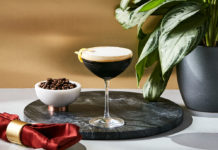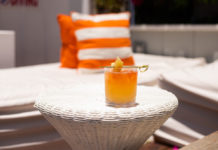
You know the old saying, “you’ve got nothing to lose and everything to gain?” That’s not quite true if you are a bar owner or manager. Even if you happen to be running one of the hottest bars in your city, your bread and butter is what you are stocking to bring your concept to life. However, there are forces at work that may compromise everything you’ve worked for.

Inventory is also one of those things where one size will not fit all. This is why companies such as Partender, Bar-i, and Sculpture Hospitality offer different services and approaches to managing spirits and other raw materials that power cocktail menus and bar concepts.
Assessing Your Inventory Goals
and Avoiding Downpours
With the pressure to keep overall operating costs down, it can be tempting to go the inventory process alone or stick to what worked well in the past. However, the increased complexity of bar operations—triggered by an ever-growing range of spirits, beer, and wine—necessitate more high-tech ways to track the in’s and out’s of a bar’s liquid assets as well as the activities of staffers handling them.
“I see people moving past pen, paper, and clipboards, and while old ways still have their place, new approaches have to be factored in to keep their business current across the board, especially as bad data in equals bad data out,” says Anjali Kundra, Co-Founder and Vice President of Operations at Partender. “With point-of-sale data alone, you’re not factoring in the hard work involved in getting a cocktail together. If one only pays attention to the bottom line to determine they are not in the red, they can lose out on the potential revenue.”
Inventory services are sometimes marketed as a theft deterrent, but Kundra feels inventory tracking should be less about policing staff and more about empowering them with knowledge about what’s in stock—enabling them to take responsibility for a bar’s success.
“I recently learned at a conference that the turnover rate at bars was something like 70%,” she says. “We are hoping the transparency element of our products and services can instead be used to improve morale and employee culture for clients. Ultimately, the goal is to provide insights and real data that can help bar owners, managers, and team members address problems, move forward with smarter sales and inventory control strategies, and end up enjoying their jobs more.” 
Kundra observes that her corporate clients may only do inventory once a month to report numbers and findings back to their bosses. Smaller clients need to do it more often not only to ensure that their beverage costs check out against their profits, but also to aid in menu planning and recipe development based on products that are moving fastest.
“In addition to having better control over the inventory, when you have greater control over what goes in and goes out, you can attain better transparency among your staff in terms of what’s poured and sold and target costs for operations,” says Kundra. “I would like to see clients thinking more holistically about their inventory and picking companies or product based on their specific needs and goals rather than just for price alone.”
Jamie Edwards, Founder of Bar-i in Colorado, notes that the bar industry is highly competitive and low margin precisely because of the discrepancy between what bartenders should theoretically pour for a given recipe and what they actually pour during their shift.
“While data we’ve collected for clients tell us bars lose a lot of money from not keeping track of their liquid assets, the same data also stresses that they can cut those losses by establishing better practices to stop overpouring and other kinds of waste,” says Edwards. “One way to [get on top of the waste issue] is to apply our software solutions to pinpoint where the shortages and overpours are and how to fix them. You need to have those costs figured out right down to the serving in an individual drink.”
In terms of picking the best service, Ian Foster, Sculpture Hospitality’s Regional Director in California, says owners and managers need to also be clear on which services will fit an individual bar’s immediate needs and how those services down the road can be adjusted as those needs change.
“If the goal is simply to do monthly inventory faster and better, there are many competitors offering apps that improve the efficiency of the inventory process,” says Foster. “If you are trying to find out if a spirit is being overpoured or not rung up correctly, however, you’ll find there are not many companies with our hands-on approach to set up your inventory system to ensure the numbers will be accurate. The majority of our clients (90%) have us do a full-service inventory as they are confident that we can accurately count, weigh, and catch more mistakes as we do these things everyday. We aim to provide results that will enable clients to take the best course of action in staving off loss, identifying related management problems, and providing recommendations to solve them.”
Foster also points out that when owners price drinks, they look at the cost of the drinks and mark it up accordingly. While this system works well, there are products you should be charging more for, such as a drink made with a quality vodka, especially if the brand is perceived by customers as premium.
When Less is More
Edwards, meanwhile, advises his clients to evaluate their product selection on a regular basis. As customers become more selective about the products they consume, bar buyers and managers should become just as picky.
“A huge mistake bars make is just adding more and more,” he says. “If you want greater profits, you need to be clever about the way you approach what to add and when. The best run bars I have seen stock fewer products but have team members with greater knowledge about those products. Owners can also use the strategy of trying out new products for three months, see what works, and then rotate them. We found that a menu with only six well-crafted well drinks is way better than an expansive list of over 30 cocktails.”
Foster, meanwhile, affirms that changes in customer drinking habits taking place in the past 25 years will impact what products should be selected and how much of them should be kept in inventory. However, stocking higher quality products can shift the costs to customers.
“Bar customers overall are drinking less, some because of drinking-and-driving concerns,” says Foster. “However, they may not necessarily spend less money when they go out. If an average person goes out with $30 to spend, chances are he will spend much of that $30.”
Foster explains that customers will buy less but spend more on quality craft beers or craft cocktails.
Foster adds that bars carry more wines and beers than they used to, and those cost more per serving. He has also had clients who have offered more by-the-glass wine offerings than they really need for their bar format, as a bottle needs to be dumped after it has been sitting around for four or five days.
“We tell our clients that if they are not selling the full bottle of a given wine within a few days, they should remove it from their by-the-glass program,” he says. “We instead suggest kegged wines as there is less risk of waste.
“We stay up on those trends because we are inside thousands of bars every day of the week doing inventory, and we get to see what every client does and what things sell best in different parts of the country, markets, and genres of bars, and from this, we can devise what the best practices are.”
“Bar owners and managers need to recognize that the register will count every single sip,” assesses Kundra. “While you may have a few hundred dollars in the register, those liquid assets you are putting on your shelves account for thousands of dollars you’ve invested in your businesses, and sometimes it’s challenging to count those assets because the process takes so long to do. You also have to consider that the bottles and casks making up those assets have a wholesale and retail value.”
From the Paper Trail to the
Tech Superhighway
Foster, a 40-year industry veteran, recalls that 25 years ago, nobody wanted to do inventory themselves. However, as technologies have gotten better and new apps are coming out, customers have greater incentive to keep track of stock between professional assessments. He points out that specific technologies, such as draft flow meters for tracking draft craft beer, have improved dramatically. He cites “Bevchek,” which shows clients in real time how much beer is being poured and what’s being rung up,. He says it has results that can be guaranteed and mechanisms that can be recalibrated when necessary.
“Today, some clients want to do the inventory themselves or at least have a hand in the process, so we now offer that option in some of our packages,” he says. “For example, we have an app that works on a smartphone with a scanner that allows clients to scan [information from] bottles. We have also expanded our product range to allow the client to do some of the work or even do all of the data entry themselves, and they pay a little less for that.”
According to Bar-i’s Edwards, some clients want to do more things independently when managing their business. In response, his firm launched an entry-level pay software product where the owner or staffer can fill out the forms on their own. When clients are ready to upgrade to a higher functioning software, their costs will still be reduced as they have done much of the work of entering their inventory into the entry-level software that will be transferred to
a more advanced program.
The advanced program can handle more of the complexity in bar operations, like batched cocktails. “We have now hit a place in the craft cocktail movement where bars pre-batch their cocktails especially in high-volume sales situations,” says Edwards. “We built this module into the software, which helps single out the costs of the various components on a large scale. It is adaptable for infused and batched drinks, no matter what kind of vessel, and still produces precise costs down to an individual drink.”
Kundra says she still encounters clients who may be hesitant to use newer inventory methods, but this fear comes as the cost of lost time. “What we want to deliver through our products is the time for clients to use information about their inventory and the sales trends related to it to make better decisions that will impact the front of the bar, and keep them front and center,” says Kundra. “Others [who shy away from newer approaches] count the pennies, but it is at the expense of what’s on the shelves.”
Edwards sums up today’s inventory programs and services as the “ultimate analytics tools” to adapt to whatever changes are afoot in the industry in days or hours rather than weeks or months. Still, the focus should remain on control versus catering to trends. “Every bar sells alcohol by the serving,” he says. “To get those costs under control, owners and managers need to look at why they may be selling more alcohol per serving than they should. You want to stay up to date, but you don’t want to focus so much on what’s hot and shiny at the expense of long-term success.”
Texas Bar Goes Big with Inventory Control
Sculpture Hospitality, a pioneer in the inventory control business, has helped thousands of bars and restaurants across the globe over the past 30 years. They see that problems with loss and lower efficiencies plague the industry. Without accurate data, it’s impossible to find the cause of lower efficiency, so their teams conduct a series of Discovery Audits with new clients where they are able to garner an exact snapshot of how a bar is performing—down to the drop!
That data and guidance is proving to be quite valuable to bars. Dallas, Texas Sculpture Hospitality franchisee, Tim Huels, notes that his business is up 40% over last year with most of that growth coming from existing clients opening new locations as well as referrals from clients who have had Sculpture Hospitality’s systems not only improve their margins, but also their quality of life.
Huels says his ideal client is someone looking to expand but that needs a better system to monitor performance and set a higher standard. Charles Houk, Owner of Southern Junction Nightclub & Steakhouse, is one of those clients.
Southern Junction Nightclub & Steakhouse opened in Royse City, Texas in 1985, and Houk bought the business in 2008. The country/western venue has a love for everything Texas—big venue, big meal, big dance floor, and big names, including Garth Brooks, Merle Haggard, and Charlie Daniels!
When Houk took over Southern Junction, he came from the world of banking with no back-of-the-house experience. “I knew inventory was important, but it took me a full eight-hour day to count, and I wasn’t even sure if I was doing it right,” he says. “I was counting everything in-house and trying hard to compare it to sales, but it was all guesswork. It may have been close on bottled beer and wine, but it was far from exact. Liquor was a total mystery. I had no idea how to account for specials, doubles, and recipes.”
Enter Sculpture Hospitality’s Bevinco bar inventory service. Houk had seen the product in action on the TV show Bar Rescue but didn’t realize he could have a local Franchisee meet him at his bar and get the data he’s always wanted in less than two weeks.
Today, Houk uses Bevinco for loss prevention, inventory management, ordering, training, and advice.
Loss prevention. “Just the fact that alcohol is counted weekly and reconciled with sales reports is huge in keeping bar staff on point,” says Houk. “The continuous feedback helps us remind them that we are watching closely. The one thing I didn’t expect is the pride that bartenders take in keeping the variances low, efficiency high, and that they police themselves to keep it that way.”
Houk says the reports also convinced him to fire a bartender he believed was stealing. “I suspected him of stealing but couldn’t figure out what he was doing. But the reports convinced me, and I let him go,” says Houk. “Firing a guy who was stealing, combined with the ripple effect among other employees who suddenly realized we were serious, had a huge positive effect on the business.”

Inventory Control. When Houk first started using Bevinco, he quickly realized that he kept too much product in-house. “Reducing inventory to what we actually use in a week does two things: keeps cash in the bank and also provides less opportunities for bottles to grow legs,” he says.
Ordering. “Ordering now takes ten minutes when using the iPar report order guide instead of an hour,” says Houk.
Training. Southern Junction’s team uses weekly awareness to improve training systems that enhance their guest experience. “Training is made easier because we all now know the exact standards that are being measured,” says Houk.
Advice. “I regularly call Tim and ask how I should read this or that number, whether it makes sense to implement a procedure, or if things just aren’t making sense with the reports,” says Houk. “We can almost always figure out what direction we need to go in these areas, and his advice is always welcome.”
With Bevinco, Southern Junction’s liquor cost reduced by over four points, and they reduced their amount of inventory on hand by 27%.
During the discovery audit, Southern Junction was losing $1,040 at cost. If just half of the venue’s losses were calculated at cost, he’d increase his revenue by over $3,300 per week, which equals $171,600 per year!
The increased efficiency from using Bevinco helped enable Southern Junction to open an even bigger second location in Irving, Texas.
“When I heard about Charles’ experience with Bevinco in Dallas, I wasn’t surprised in the least that they were able to open a second location simply because they were using the Bevinco service,” says Jon Taffer, Host of Bar Rescue. “Anyone serving alcohol needs to have these controls in place for their liquor, wine, and beer—so stop with the excuses and call Bevinco.”
When opening the second location, Houk’s first phone call was to Huels. “He helped with opening inventory, training, and getting started out on the right foot,” says Houk. “That helped set the culture on the front-end instead of having to correct it over time.”
sculpturehospitality.com/barbizmag








